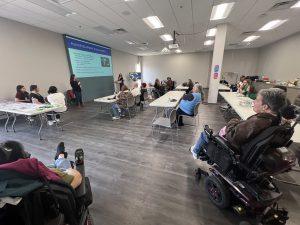
Mobility – getting safely and easily from one place to another – is often a pathway to happiness, health, and prosperity.
This is particularly true for seniors and individuals with a disability because mobility enables human connections and access to employment, health and other services, nutritious food, parks and gyms, and social and cultural gatherings. This is important, because recent U.S. Census Bureau figures find that the population of the St. Louis region as a whole is growing older at an increasing rate. There are approximately 418,101 seniors age 65 and over in the St. Louis region – about 16.3% of the population, according to the U.S. Census. And, though the number of individuals with disabilities in our region has declined over time, they make up nearly 13% of the 2.6 million people in our region.
Which begs some questions: Is the region, as a whole, serving the mobility needs of these two populations, and how do we make sure that limited federal funding is used to improve their mobility so they can thrive?
On Wednesday, April 24, the EWG Board of Directors is expected to approve the final draft of EWG’s 2024 Coordinated Human Services Transportation Plan (CHSTP) for the St. Louis region. Developed by the Transportation Planning Department through data analysis, partnerships with relevant agencies, and public input, the CHSTP identifies needs and gaps in transportation services for seniors and individuals with disabilities and recommends priorities and strategies to address them.
With a modest $2.9 million pool of federal money available to the EWG region through the Enhanced Mobility for Seniors and Individuals with Disabilities (Section 5310) Program, the new CHSTP provides agencies and jurisdictions regional priorities and goals for proposed projects needing funding. Funding decisions are made by EWG and allocated to proposed projects that best address gaps, needs, and priorities. About 60% of Section 5310 funding goes to vehicle purchases and upgrades, another 40%goes to service expansions, ADA and accessibility improvements, pilot programs, and more. Nonprofit organizations, local government authorities and operators of public transportation are eligible to apply.
The last CHSTP was completed four years ago in 2020 before the onset of COVID-19. Although transit use remains down from the pandemic, demand for mobility services for those most in need is ticking up. The report finds, “that many existing gaps and needs were exacerbated by the COVID-19 pandemic, bringing many of these issues to a crisis level in the St. Louis area and across the country in some cases.”
Additionally, the region straddles two states and contains a diverse mix of urban, suburban, and rural areas. The areas require differing types of mobility services – and those services can be particularly costly in rural areas where housing and services are spread out over wide distances.
The plan cites five areas of concern regarding gaps and unmet needs: affordability, reliability, coordination, technology, and environmental/social. Key points include:
Affordability: Many seniors and disabled individuals struggle with affording specialized mobility services from both the public and private sector because rising operational costs are being passed on to them. Providers face difficulty in accessing regular funding for vehicle replacements and maintenance, straining their budgets as older, less reliable vehicles stay on the road longer.
Reliability: Users of specialized mobility services say systems are not reliable, particularly regarding cancellations, unanticipated higher travel times, re-routing, and limited service hours. Service vehicles are not always accessible for the disabled, and pick-up and drop-offs don’t always included specialized assistance to get a rider from a residence into and out of a vehicle. Providers also cite issues with driver recruitment and retention.
Coordination: Users deal with service fragmentation that makes it difficult to travel across different jurisdictions and service boundaries. Different providers don’t coordinate services, and funding for the providers is fragmented. Users also report a hard time getting schedule information and directly contacting providers.
Technology: The advent of ride-sharing/hailing companies has increased service, however, those rides are rarely accessible for all users. There is also a lack of standardization of ride software, and, this software is vulnerable to hacking.
Environmental and Social: Problems with infrastructure, including broken sidewalks, non-ADA compliant curb cuts, and more inhibit access to public transit and other mobility options. An aging population both in the St. Louis region and nationally generally prefers to age-in-place in existing homes which are not always accessible to mobility routes. New suburban and rural housing and developments often continue to remain auto-dependent. And, safety concerns about public and private transit remain high.
EWG’s production of a CHSTP every four years is mandated by federal law as part of the federal Section 5310 Program. Chapter six of the CHSTP outlines a complete summary of goals and strategies to address the gaps and challenges for seniors and individuals with disabilities.
Regional high priorities include:
- Fund maintenance and/or replacement of vehicles and equipment to sustain or expand services.
- Advocate for more flexible funding to support the maintenance and operations of existing fleets.
- Increase service in or to underserved geographic areas.
- Expand availability of specialized or assisted transportation services.
- Support rider subsidy and voucher programs.
- Seek out public-private partnerships for new funding opportunities and assistance.
- Improve communication between funders and transportation providers.
- Make transportation services more frequent, on-time, and with less advance notice required.
- Support wage increases and programs to improve staff and driver recruitment and retention.
- Shift the cultural narrative to normalize aging and disability.
- Develop software platforms that can serve a pool of agencies to meet shared needs.

